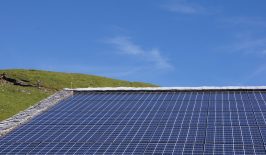Solar power is often hailed as one of the most important elements of a carbon-free future. However, solar power is not without its disadvantages, most notably the intermittent nature of its energy source. Not only is solar power limited by the day-night cycle of the sun, but it is also dependent on favourable geographic location and weather conditions – all of which affect its reliability as a major energy provider.
Chinese engineers, however, are looking to overcome these limiting factors by taking solar power plants into the final frontier: space.
Solar power in space is nothing new. Afterall, all our satellites, space stations and space craft depend on solar power for their energy. The hurdle to space-borne energy plants, however, is transmitting that power back to Earth. As of yet, no one has been able to, affordably, crack this issue. Even the Chinese engineers expect the process to take at least 30 years of research and development.
Space Age Solar Farms
Now, according to NBC, China is looking to do just that by building a specialist test facility in the south-western city of Chongqing. The exact details of the Chinese plan have not been made public, however experts who are also working on this issue can make some reasonable assumptions about the technology behind the venture.
Previous concepts, like the one illustrated above, theorised on the use of mirrors to reflect sunlight into a central microwave dish which would beam the energy back to Earth. NASA physicist, John Markin, who worked on similar projects in the 1990s, also suggests swarms of solar satellites could be used to combine into vast networks – akin to satellite ‘cones’ – which would use advanced photovoltaic panels to turn solar radiation into power before similarly beaming it down to giant receivers on Earth. These receivers – consisting of giant wire nets up to seven kilometers across – would most probably be built in deserts, on lakes and seas and on farmland. From here, it would be transferred into the normal energy grid.
Mankin suggests such a concept would routinely generate 2000 gigawatts of power. The largest terrestial solar farms, in ideal conditions, rarely generate more than 1800 gigawatts. Such an output, Markin suggests, could hold the key to solving our long term energy issues.
The Giant Leap Required
Gathering solar energy in space clearly comes with a number of advantages. Space-based solar farms can be exposed to the sun’s rays for much longer, and are not affected by weather or atmospheric conditions. According to Ali Hajimiri, a professor of electrical engineering at the California Institute of Technology and director of the university’s Space Solar Power Project, space solar farms could be eight to nine times more efficient than even the largest terrestrial plants.
To be economical, and despite recent advances, space solar panels would have to become even lighter, without sacrificing their efficiency, while the Earth-based receivers would also be major engineering and architectural works requiring lots of land – and most importantly – money. Additionally, engineers would also need to develop sophisticated and rapid launch vessels to deploy the number of satellites required.
Mankin estimates that even a small scale test would cost in the region of 150 million USD, while a working prototype of his swarming satellite version would likely exceed 10 billion USD. Despite this, the National Space Society states these costs are much lower than US military involvement in the Persian Gulf and also less than the increasing costs of climate change are likely to be in the future.
In any case, it must be stressed that the concept of a space-based solar plant will not be coming any time soon, with Chinese authorities stating that they hope to have a functional version in operation by 2050. Although this leaves plenty of time for technology to develop – and China has been aggressively pursuing both solar and space technology in recent years – it also leaves a lot of time for political agendas and priorities to change, not to mention economic factors to come into play.






